125th Evacuation Hospital Unit History

Illustrated map showing the route of the 125th Evacuation Hospital through Europe.
Introduction:
The 125th Evacuation Hospital, Semimobile, was officially activated on 27 March 1944 at Camp Maxey, Paris, Texas (Division Camp, acreage 36,683, troop capacity 2,022 Officers & 42,515 Enlisted Men –ed). Lt. Col. Ralph G. Ball, MC was appointed as the unit’s Commanding Officer, with Maj. Charles R. Sharp, MC acting as Executive Officer, Adjutant, Supply Officer and Registrar. The Hospital’s Headquarters were established with a complement of 34 Enlisted Men. This cadre was made up principally of men from the 110th Evacuation Hospital.
Officers and Enlisted Men continued to arrive throughout April until the required EM strength as allocated in the Table of Organization had been achieved. Considerable time passed, however, before a complete staff of Officers joined the unit.

Portrait of Lt. Col. Ralph G. Ball, Commanding Officer of the 125th Evacuation Hospital.
Training:
The following two months proved trying for all members of the Hospital. Extensive basic and specialized training took place for recruits. Daily close order drills, road marches, obstacle course routes, tent pitching, infiltration course exercises and the tactical night problems in blackout were all introduced to develop the coordination, awareness, skill, speed and stamina necessary to the unit’s personnel.
Additional training was also provided for the numerous professional fields; surgery, dentistry, pharmacy, x-ray and laboratory work.
The Nurses arrived for assignment with the unit during the closing phase of personnel training. However, before the period could be completed, the 125th was alerted for participation in the Louisiana Maneuvers. The packing of and familiarization with hospital equipment became the order of the day. Speed was essential for movement orders might be received at any time; such orders never came. Instead, the day before the movement deadline, the 125th Evacuation Hospital’s participation was postponed indefinitely.
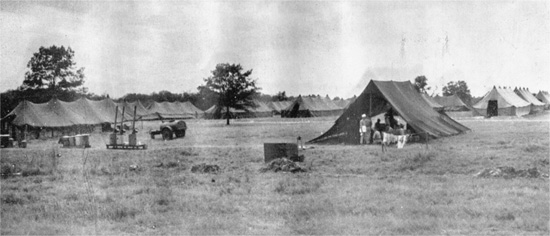
General view showing the tented facility established at Camp Maxey, Paris, Texas by the 125th Evacuation Hospital.
Rather than resume quarters and recognizing the need for more field experience, the unit’s Commanding Officer decided to set up and operate in an area within Camp Maxey, close to the Regional Hospital. Arrangements were made and the hospital was set up. Operation started on 28 August 1944. A few mistakes in the first days of the exercise were soon overcome and the unit’s personnel adapted to the mud and rain in which they found themselves, and training carried on as planned.
On6 October 1944, Lt. Col. Leo J. Butler was appointed as Commanding Officer for the 125th. The appointment was short however, as he was relieved of his assignment just 13 days later, when Col. Ball resumed command.
Finally, an inspection by senior medical staff from the Fourth United States Army was held, and the unit passed the numerous tests and requirements with flying colors – the 125th Evacuation Hospital was now officially ready for active duty. All of the necessary equipment was packed and the unit returned to barracks, and final furloughs were issued to all staff.

Personnel of the 125th Evacuation Hospital undergo training in ward work. Photograph taken at Camp Maxey, 1944.
Preparation for Overseas Movement:
On 27 November 1944, the 125th Evacuation Hospital left Camp Maxey for Camp Kilmer, Stelton, New Jersey (Staging Area for New York Port of Embarkation -ed). Processing at Camp Kilmer was brief, and consisted mainly of “abandon ship” drills and instruction in entraining and detraining. Passes were issued, and the personnel seized the opportunity to visit New York City, a first for most of the Texans and Tennesseeans.
On the evening of 8 December 1944, the unit embarked on a troop train to be carried to the docks at the New York Port of Embarkation. At the dockside, American Red Cross workers were handing out hot coffee and donuts to help ease nerves. The unit soon organized itself by roster, and prepared to board the British ship “Dominion Monarch” which had formerly been a luxury liner on the Australian ocean lanes.
The large vessel set sail early the following morning, and by daybreak was far beyond the shores of America.
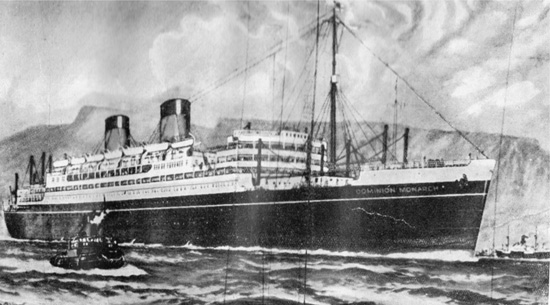
Exterior view of the British liner “Dominion Monarch”, which transported the 125th Evacuation Hospital across the Atlantic to Great Britain.
After 11 days at sea, land was finally sighted, and the ship docked at Southampton, England on 20 December 1944. It was to be two days however, before the personnel unloaded and the men occupied the time watching the equipment being transferred by huge electric cranes from the ship to the dockside. Tragedy came when T/Sgt Bernard Weintraub was killed when a large case slipped from its ropes and fell to the deck, striking him on its way and crushing his skull. His death was a shock to everyone aboard.
Upon debarkation, the unit immediately entrained for Tenby, South Wales and to quarters at a former British Army garrison to undergo further training and experience in the role and functions of a US Army Evacuation Hospital.
England:
The unit finally arrived at the camp in Penally, Wales and began unloading equipment and making the necessary preparations for its stay. The camp was to be shared with the 130th Evacuation Hospital, which had also traveled across the Atlantic on the same trip as the 125th. For quarters, the enlisted personnel were located in cantonment-type wooden barracks, while the Officers and Nurses were housed in metal Nissen huts.
Christmas was spent at this new post, and the Mess Section did its best to bring some of America to the mess hall by providing roast turkey complete with stuffing and cranberry sauce. In the afternoon, Officers and Nurses exchanged gifts at a party, and later in the evening, the Nurses gave a party in the recreation hall for the Enlisted Men and presented each man with a small gift.
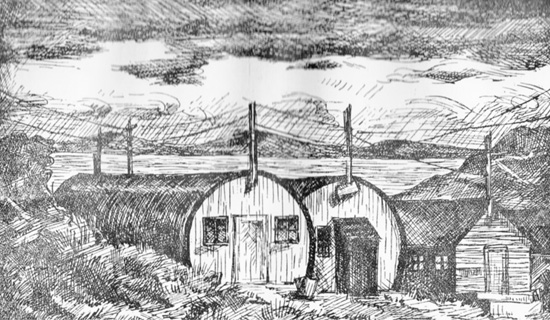
Ink sketch depicting the camp in Penally, Wales where the 125th was stationed during its time in England.
On 8 January 1945, the majority of the unit’s Medical Officers, all of its Nurses and 78 Enlisted Men were detached from the organization for temporary duty at various numbered General Hospitals in England. The personnel became familiar with the care and handling of actual battle casualties for the first time, as well as the uses and limitations of penicillin therapy, and the techniques of caring for trench foot.
On 21 January 1945, the 125th Evacuation Hospital was reassigned to the Fifteenth United States Army, and all personnel were recalled and an extensive training program was begun.
A few days later, the unit’s transport arrived, and the Motor Pool Section immediately began the assembling of the vehicles and their markings. Convoys were formed and runs of twenty to forty miles were made to familiarize drivers and assistant drivers with English roads and the custom of driving on the left hand side of the road. Convoys under blackout conditions were also made and practised. Each section of the hospital was busy marking equipment and formulating loading procedure in order that all equipment could be transported readily and safely.

The MV Llangibby Castle carried the 125th Evacuation Hospital across the English Channel and into France.
The advance party, comprising 1 Officer and 5 Enlisted Men departed from Camp Penally on 25 February 1944, and two weeks later, at 0600 on 10 March 1945, the motor convoy left for the marshalling area. On 12 March 1945, the balance of the unit entrained at Tenby and arrived at the port of Southampton after an overnight journey. Immediately upon arrival, the personnel embarked on the MV Llangibby Castle, and crossed the English Channel under armed escort without mishap. The new destination was now known – France.
France:
The unit arrived at the port of Le Havre, France, on 14 March 1945. Upon debarkation, the Nurses were transported by the unit’s motor transport to Mesnières-en-Bray, while the Officers and Enlisted Men embarked on a US Navy riverboat. The following day, the unit made a voyage up the Seine River to Duclair, where it proceeded to the Staging Area known as “Camp Twenty Grand” (one of many “Cigarette Camps” located at Hénouville –ed).
Here, the unit was assigned an area in the large tent city with mess and sanitary facilities furnished by the Transportation Corps. The weather was cold and personnel had to resort to cutting fire wood and to the setting up of tent stoves to keep warm. The unit’s Nurses were billeted in the buildings of an old château at Mesnières-en-Bray.
On 22 March 1945, the 125th Evacuation Hospital was ordered to move to Château-Regnault. In order to avoid the discomfort of personnel traveling by rail in freight cars, a shuttle movement with the unit’s own transport was established. The 250-mile shuttle move required three days but was accomplished without difficulty.
The new station lacked running water and toilet facilities. The unit was billeted in buildings, but not before much labor had been spent to clean and prepare them. Sanitary facilities were inadequate so that field-type latrines had to be set up at each billet.
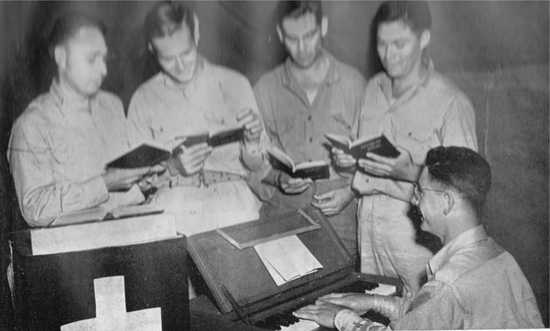
The unit’s Chaplain, Earl N. Engle conducted regular Sunday services during the unit’s tour of duty in Europe. Here he is depicted alongside four Technicians from the unit during such an occasion.
Ward tents were pitched and the task of unpacking the hospital’s materiel was begun. With the idea in mind of knowing the difficulties and handicaps under which an Evacuation Hospital worked in the field, Officers, Nurses and Enlisted Men visited the 34th, 109th, 110th, 121st Evacuation Hospitals which were already functioning in the area. Here it was noted that it was more expedient to leave a casualty on the same litter upon which he arrived until he reached the ward. In addition, it was noted that all hospital personnel were divided into two 12-hour shifts and that the hospital could not function efficiently without an increase in personnel. Enlisted Men had to be used as an armed guard for the hospital and for other details that had not been counted upon.
The stay at Château-Regnault lasted up to April, but on Easter Sunday, new orders were received which committed the unit to travel to Krefeld, Germany. The Hospital immediately began to pack its equipment and on 3 April 1945, the whole of the 125th’s personnel moved out to Germany.
Germany:
The unit traveled through France, Belgium and Holland, finally arriving at its new home on the eastern bank of the Rhine at approximately 0000 hours on 5 April 1945. The unit learned that it was to support the 94th Infantry Division which was occupying a holding position on the west bank of the river. The site that had been pre-selected for the hospital was a large racetrack on the outskirts of Krefeld. Staff immediately got to work unpacking the necessary equipment to make the hospital ready for battle casualties.
The bomb-damaged racetrack was located approximately 2 miles from the river. Its location made it necessary to operate at night under strict blackout conditions. The unit’s first night in Germany was never to be forgotten. Not fully aware of the closeness of the enemy, one unit member built a small bonfire with which to keep warm whilst on guard. Shortly after lighting it, a heavy barrage of artillery fire was heard overhead, and continued for most of the night. The artillery barrages would continue in a similar vain for a further week, but did not impair the handling of patients. A few of the Nurses made serious attempts to prepare fox holes large enough in which to sleep.
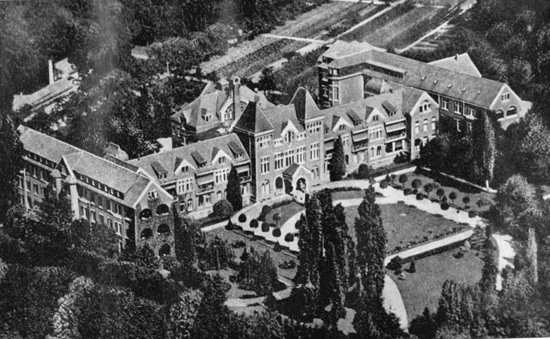
Aerial view of the St. Francis Hospital, located in Mönchengladbach, which was occupied by the 125th Evacuation Hospital.
Shortly after the barrages had ceased, orders were received that the hospital was in an unsafe position and was therefore to move, with its patients, back to the outskirts of Mönchengladbach.
In the new area, a much more satisfactory set up was laid out. Personnel were divided into two shifts of 12 hours. Each shift worked from 0700 to 1900 or from 1900 to 0700. A penicillin team of two Enlisted Men was formed with the sole purpose of administering penicillin continuously throughout the hospital.
As the unit continued to function, personnel were shifted as necessary to sections where the patient load was heavier in order to prevent the formation of bottlenecks. Additional personnel were received from the Army to act as armed guards for the facility, and civilians were hired to carry out physical tasks.
As the patient load decreased some personnel were able to leave the facility and collect a few souvenirs and war trophies.
One of the major problems was the evacuation of patients during this period. Ambulances for evacuation were attached to the unit. The various sections of the hospital cooperated to the utmost in order that such evacuation might be done speedily and efficiently. The Dispensary and Outpatient Department were constantly busy with the patients from the many small units which were without Medical Officers. The Dental Clinic was also extremely busy.
After a month in the field, the unit was ordered to move once again, but this time into permanent buildings. A reconnaissance was made and the 200-bed St. Francis hospital was selected as an ideal site for the unit. This new site was located approximately 2 miles from the field set up, on the road to Viersen. Before personnel could move, it was necessary to remove the few civilian patients to other German hospitals and to fully clean the buildings prior to moving in. The move was finally completed on 1 May. 150 folding cots were added to the 200 beds to raise the patient capacity to 350. For the most part, organizational equipment was utilized in the building. The 70 Catholic sisters who had previously operated the hospital remained behind and continued to work with the 125th.
The main building was used to house the patients, Officers and Nurses, while two separate buildings were used to accommodate the Enlisted Men. All buildings were untouched by the war and were in excellent condition. Mess facilities were splendid for steam pressure cookers, mechanical refrigeration and a complete bakery were available in the building. A large mess hall for patients and detachment personnel was also in this building, as well as a large laundry which was operated by local civilians.

Staff from the Hospital’s Motor Pool Section check over vehicles in preparation for the unit’s move to Bad Kreuznach, Germany.
With the coming of victory, there was a decrease in hospital admissions and a corresponding increase in free time. Softball, football and volleyball teams were formed and games were scheduled with teams of neighboring units. The hospital grounds were spacious and provided ample room for outdoor entertainment by the USO. The unit’s newspaper, The Gauzette which had ceased publication with the 125th’s departure from the United States was printed and circulated daily once again. Officers, Nurses and Enlisted Men were issued with passes and furloughs, allowing them time to explore Paris and the French Riviera.
Orders were then received to close the facility at Mönchengladbach, and plans had been put in place to move to Bad Kreuznach, to take over the professional facilities of the 136th Evacuation Hospital. Thus, on 11 June 1945, the evacuation of patients was made to the 32d General Hospital in Aachen.
During its 68 days of operation, the 125th Evacuation Hospital had received 2,141 patients. There were eight deaths resulting in a mortality rate of just 0.37%. The breakdown of patients was 1,030 medical and 957 surgical cases. The remainder were cases carded for record only.
After VE Day, casualties rapidly declined and the percentage of medical cases climbed. Prior to this period, surgical cases consisted chiefly of actual battle casualties with wounds of the extremities predominating. After the cessation of hostilities, the surgical cases were acute abdominal conditions and elective operations. Medical cases consisted mainly of acute infectious conditions such as pneumonia, infectious hepatitis, diphtheria, and upper respiratory infections. Three patients were also admitted with acute methyl alcohol poisoning who did not respond to therapy and died. Another noteworthy case was that of a 16 year old liberated Russian slave laborer who had been starved down to a weight of only 45 pounds. He responded to intravenous feedings and transfusions and was soon able to take nourishment orally.
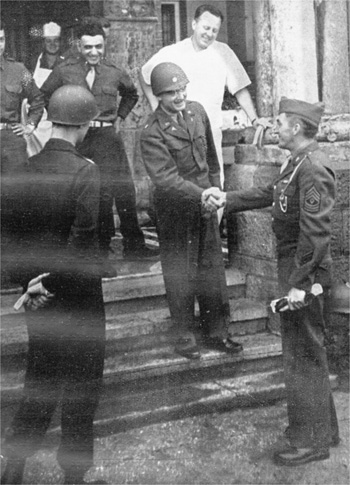
The first “High Pointer” of the 125th Evacuation Hospital prepares to leave the unit for return to the Zone of Interior. Photograph taken June 1945.
Before unloading began at Bad Kreuznach, the 125th’s orders were changed. The unit was sent to bivouac in a field just outside the town. Instructions were given not to function and the 125th was alerted for direct redeployment to the Pacific Theater of Operations. The Commanding Officer selected a new site on the bank of the Nahe river, and squad tents were pitched for enlisted personnel. Officers and Nurses were quartered in the Quellenhof Hotel overlooking the river.
Some time was spent in correcting shortages of equipment and clothing, the turning in of excesses previously issued by the Medical Department and the requisitioning of total T/O strength. Personnel with an ASR score of 85 were transferred out of the unit. Classes were held in Japanese warfare and on the prevention of malaria.
On 30 June 1945 the 125th left Bad Kreuznach for Camp Philadelphia (Reims Assembly Area Command –ed) in Reims, France. Aside from the general daily deportment of the hospital, the personnel had little else to occupy their time in the camp. Furloughs were readily available, and trips were planned to Belgium, Paris and the French Riviera.
France:
At 0200 on 15 August 1944, the whole staff of the 125th Evacuation Hospital were woken by the incessant pealing of the bells in the camp’s chapel; news had been received of the Japanese surrender. Despite this however, orders for the 125th still read for shipment direct to the PTO through the port of Marseille.
On 26 August 1945, the unit loaded into third class French rail coaches and headed for Marseille. All personnel were convinced they were homeward bound. The 600-mile railroad journey down the length of France took almost 60 hours and personnel suffered many sleepless nights as a result. The unit finally reached Camp Arles (Staging Area) at 0200 on 29 August 1945.
Upon arrival, excess equipment was turned in and personnel received authorizations to carry war trophies aboard and past the customs in the States. Final preparations were made for boarding.
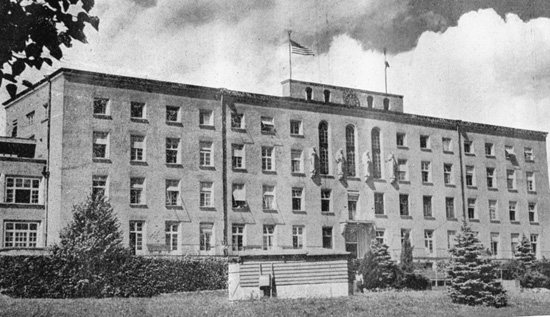
Exterior view of the facility occupied by the 125th Evacuation Hospital at Passau, Germany.
Numerous delays meant that the 125th was waiting in the staging area at Arles for several days. When movement orders were finally received, they were no longer for boarding a ship, but rather to transport all personnel to Camp St. Victoret for a few additional days of waiting. Upon arrival at the camp, all “high pointers” were transferred out of the unit, and the remaining personnel resigned themselves at last to the prospect of remaining in Europe for an indefinite period. Rumors became more frequent with each day that passed.
Finally, orders were received that the 125th would once again return to Germany to relieve the 110th Evacuation Hospital at Passau, Germany.
The End:
On 20 September 1945, all Enlisted Men of the 125th boarded motor transport and embarked upon the four-day trip into Germany. The only Officers who remained of the original group that had come overseas with the unit were the Commanding Officer, the MACs and the Chaplain. The Nurses were almost all new in the unit.
The convoy made one-night stops at transient camps en route at Dijon and Nancy in France, and Nürnberg in Germany. The journey was finally completed on 24 September. Three days later, the operation and command of the 125th Evacuation Hospital officially changed hands. The unit was to service the 83d Infantry Division, which would move to Austria three weeks later, seeing the administration of the area transferred to the 4th Armored Division.
Professional duties were comparatively light with more time devoted to athletics and social activities. Tours into the mountains of Germany, with cruises down the Danube River offered everyone an opportunity to witness the beauty of the Bavarian countryside. Old age and the ASR system caught up with many Officers, Nurses and EM. By the end of November 1945, the unit was far below T/O strength.
Roster:
Officers:
| Albers, George D. (Capt.) | LeForli, Robert V. (1st Lt.) | Shannon, Thomas R. Jr. (Capt.) |
| Ball, Ralph G (Col., Commanding Officer) | Lenhoff, Charles D. (Capt.) | Sharp, Charles R. (Maj.) |
| Biggs, Thomas G. Jr. (Capt.) | Leslie, George L. (Maj.) | Sheppard, Robert C. (Capt.) |
| Bradley, Thomas (Maj.) | Lester, Thomas W. Jr. (Capt.) | Shirley, Cyrus (WO) |
| Butler, Leo J. (Lt. Col.) | Loomis, Frederick J. (Capt.) | Siegel, Saul (1st Lt.) |
| Cartee, James K. (1st Lt.) | Maloney, John J. (Maj.) | Smith, Edward J. (Capt.) |
| Chandler, Swithin Jr. (Capt.) | Markle, Joseph G. B. (Capt.) | Spohn, Albert H. (Capt.) |
| Chesledon, Wayne A. (Capt.) | McCellan, James T. (Capt.) | Squires, Raymond B. (Capt.) |
| Clubb, Elmore M. Jr. (Capt.) | Mees, Theo H. (Capt.) | Stanfill, Charles M. (Maj.) |
| DeCavit, Howard F. (Capt.) | Miller, Clyde E. Jr. (Capt.) | Stewart, James B. (Capt.) |
| Douglas, Edward W. (Maj.) | Moomily, George S. (1st Lt.) | Sweeney, John W. (Capt.) |
| Egan, Thomas A. (Capt.) | Napolilli, Francis A. (Capt.) | Tryka, Bruno J. (Maj.) |
| Ellis, John M. Jr. (1st Lt.) | Neaverth, Elmer J. (Maj.) | Tupper, Walter R. (Maj.) |
| Engle, Earl N. (Capt., Chaplain) | Ortner, Alvin B. (Capt.) | VanDuyn, Thomas S. (Capt.) |
| Frobese, Alfred S. (Capt.) | Pagano, Aurelius J. (Capt.) | Weber, Bernard A. (Maj.) |
| Garner, Fay L. (Capt.) | Porter, Charles E. (1st Lt.) | Wilson, Norman L. (Capt.) |
| Gershberg, Herbert (Capt.) | Powell, James H. (Capt.) | Windler, Robert R. (1st Lt.) |
| Hecker, John T. (Capt.) | Recordon, Lawrence G. (Capt.) | Wood, Ernest H. (Capt.) |
| Heffernan, John A. (Capt.) | Rendok, John H. (Capt.) | Woodall, William P. (Capt.) |
| Heinrich, Weston A. (Capt.) | Richardson, James A. (Capt.) | Young, John D. Jr. (Capt.) |
| Hilker, Albert W. (Capt.) | Schmidt, Eldon M. (WO) | Zents, Leo J. (1st Lt.) |
| Knudson, Jack R. (Capt.) | Schwartz, Edward D. (Capt.) | |
| Kowalski, John S. (Capt.) | Seacat, Dennis H. (Capt.) |
Nurses:
| Abbey, Martha E. (2d Lt.) | Grunland, Ruth E. (2d Lt.) | Parham, Mary J. (2d Lt.) |
| Anderson, Gertrude L. (1st Lt.) | Hall, Florraine P. (2d Lt.) | Patterson, Kathleen T. (2d Lt.) |
| Anderson, Veronica J. (2d Lt.) | Harp, Dorothy L. (2d Lt.) | Philippe, Patricia H. (2d Lt.) |
| Baldy, Mary A. (1st Lt.) | Hewitt, Marie C. (2d Lt.) | Phillips, Catherine A. (1st Lt.) |
| Barton, Caroline B. (1st Lt.) | Johnson, Dorothy A. (2d Lt.) | Quetchenback, Jeanne F. (2d Lt.) |
| Begley, Cecilia C. (1st Lt.) | Johnson, Viturah E. (1st Lt.) | Riddett, Elsie A. (1st Lt.) |
| Berman, Julie L. (1st Lt.) | Knodel, Edna P. (2d Lt.) | Robinson, Anna I. (2d Lt.) |
| Bruce, Elaine W. (2d Lt.) | Larkin, Alice C. (2d Lt.) | Rozema, Mary (1st Lt.) |
| Burns, Marie M. (2d Lt.) | Linkel, Mary E. (1st Lt.) | Ryan, Lillian A. (1st Lt.) |
| Cavagnaro, Louise P. (1st Lt.) | Luce, Kathleen E. (2d Lt.) | Spengler, Jeanette A. (2d Lt.) |
| Cochran, Luella B. L. (2d Lt.) | MacDonald, Verna E. (1st Lt.) | Spezio, Mary J. (2d Lt.) |
| Coleman, Louise H. (2d Lt.) | Main, Cleo B. (2d Lt.) | Stuckey, Leila C. (1st Lt.) |
| Cunningham, Minnie A. (1st Lt.) | Massari, Angela P. (2d Lt.) | Taggart, Joyce L. (2d Lt.) |
| Dirig, Catherine A. (2d Lt.) | Mauldin, Wilma H. (2d Lt.) | Teplitsky, Rose (1st Lt.) |
| Dougherty, Betty P. (1st Lt.) | McCulla, Mary J. (2d Lt.) | Vogelaar, Anne C. (1st Lt.) |
| Dumroese, Muriel E. (2d Lt.) | McMillan, Mary K. (1st Lt.) | Wagener, Mary M. (Capt.) |
| Eckel, Virginia M. (2d Lt.) | Mills, Evelyn M. (2d Lt.) | Wheatley, Margaret F. (1st Lt.) |
| Eingrieber, Margarethe C. (2d Lt.) | Minghan, Hellen M. (1st Lt.) | Whitefield, Dorothy P. (2d Lt.) |
| Falk, Marjorie A. (1st Lt.) | Myres, Helen L. (2d Lt.) | Willers, Aurelia A. (1st Lt.) |
| Fehrmann, Ruth A. (2d Lt.) | O’Hara, Mary L. (2d Lt.) | Woestman, Betty J. (2d Lt.) |
| Freeman, Elaine Z. (1st Lt.) | Oral, Patricia V. (1st Lt.) | Young, Rubye D. (2d Lt.) |
| Galbraith, Lucille E. (1st Lt.) | Paesano, Josephine O. (1st Lt.) | Zebrack, Rose (2d Lt.) |
| Graf, Alice M. (2d Lt.) | Palmer, Charlotte H. (2d Lt.) | Zembower, Joyce A. (2d Lt.) |
American Red Cross Workers:
| Bishop, Agnes | Fox, Marguerite | Sinclair, Margaret |
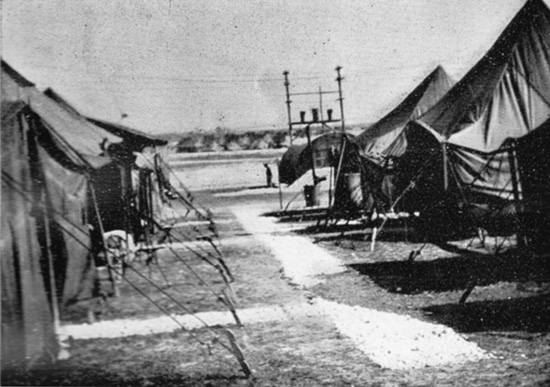
Photograph illustrating the Company Street occupied by the 125th Evacuation Hospital at Camp Philadelphia, France.
Enlisted Men:
| Alford, Sidney E. | Griffin, John L. | Portell, James A. |
| Algren, Nelson | Griggs, James W. | Powers, Patrick J. |
| Allen, Herman E. | Gross, Herbert | Premack, Dave |
| Ambriz, Albert P. | Hall, Robert W. | Putney, William J. |
| Arbaugh, Pearly E. | Haller, Otto C. | Ragan, J. T. |
| Arnett, Johnnie | Hanna, James B. | Ramsey, Richard C. |
| Ashford, Benjamin B. | Haraldsen, Kenneth J. | Reid, Gordon B. |
| Auffert, Franklin E. | Harper, Elbert R. | Richards, John W. |
| Baggert, Billie E. | Harrington, Robert P. | Riesgraf, Robert R. |
| Baker, George W. | Harris, Elvon L. | Rinker, George W. |
| Baker, Norman H. | Harvey, Richard J. | Robins, Kenneth P. |
| Barkley, Ward D. | Harward, Jesse H. | Robyn, Wallace M. |
| Barlos, Milan P. | Hatcher, Thurmon I. | Rodriguez, Lupe |
| Bates, Homer C. | Hayes, Joseph J. | Roe, Arthur J. |
| Batt, Gerald B. | Helgerson, Donald A. | Rosen, Alan |
| Beller, Fred Jr. | Hendrix, Fred | Rotes, Eugene R. |
| Bender, Edward W. | Hesterman, Edward M. | Rothenberg, Herbert R. |
| Benton, Herbert R. | Hicks, Milford L. | Rudolph, Donald R. |
| Binegar, Warren A. | Hilt, Donald E. | Rupp, Ernie J. |
| Bischoff, Robert F. | Hoffman, Edward A. | Russell, Edd M. |
| Bixby, Robert E. | Holleman, Paul M. | Sagrans, Hugh D. |
| Blain, Eldridge | Holloway, Roy W. | Sanders, Vernon E. |
| Bonin, Aldest J. | Holly, Claudie L. | Sanhamel, Joseph E. |
| Box, Douglas W. O. | Hovey, Robert M. | Sartorius, Claude Jr. |
| Brady, Robert J. | Hurd, Lloyd B. | Scarborough, James W. |
| Brenna, Lloyd J. | Jaye, Nolan L. | Scates, William M. |
| Bretz, Stanley | Jennings, Wallace P. | Schaffer, Frank M. |
| Broughton, Maynard E. | Johnson, Lewis H. | Schubert, Carl H. |
| Bruce, Donald R. | Johnson, Theo L. | Schuler, Thomas J. |
| Burgess, James B. | Jolly, Robert E. | Scott, Lonnie E. |
| Burhans, Frank C. | Jones, Orvis E. | Seaberry, James F. |
| Byington, Melvin B. | Jones, Raymond | Sellman, Walter H. |
| Calvert, L. W. | Jordan, Leonard R. | Seyler, Lawrence G. |
| Caminos, Louis | Keller, Henry R. | Sharp, James R. |
| Cappel, Leighton J. | Kent, Charles M. | Sharrow, George F. |
| Carr, Charles A. | Kimszal, Raymond A. | Shenton, Alfred B. |
| Cattuzzon, Nino L. | Kincer, George J. | Shepherd, Cecil L. |
| Chaney, James A. | King, Luther D. | Sherman, Jack L. |
| Chandler, Gilbert A. | Kirk, Willis E. | Simpson, Grady R. |
| Cheevers, Richard D. | Komorowski, Ronald A. | Sizer, Robert F. |
| Childers, Louis M. | Koole, Nelson G. | Smith, Alton L. |
| Cirullo, Joseph | Kowalski, Walter | Sourile, William J. |
| Clark, Delbert L. | Ladnier, Herbert E. | Spaulding, Rolland W. |
| Clark, Thomas I. | Lampes, Nicholas J. | Speck, William L. Jr. |
| Cohen, Harry | Lane, Verlin L. | Spivey, Marvin |
| Cole, Willard C. | Langley, Raymond C. | Stahl, Raymond |
| Collier, Edsel L. | LaTour, Louis B. | Stanford, Lloyd C. |
| Cornett, Harrell H. | Leary, Julius L. | Steel, John M. Jr. |
| Costabile, Michael P. | Lehto, Archie G. | Stetter, Harry R. |
| Cox, Chester Jr. | Leitschuh, Alfred W. | Stevens, Carl O. |
| Crawley, George H. | Lentz, Robert W. | Stewart, Millard C. |
| Daley, Robert I. | Lill, Ralph L. | Stuck, John L. |
| Davis, Harry M. | Lind, Edwin H. | Tapjian, Robert M. |
| Davis, Loyal E. | Lindskog, Maurice B. | Tate, Cecil |
| Day, Earl D. | Lipke, Robert R. | Thrash, Gordy A. |
| Debbis, Abraham | Loomis, Richard H. | Thuerk, Ervin D. |
| DeFotis, Nick C. | Lowery, William J. | Tiner, Robert C. |
| DiBiasio, Damiano C. | Lowry, John Q. | Tinker, Frank P. |
| Edelman, David J. | Magrino, Vito P. | Travis, Tony C. |
| Edmonston, William C. | Maitland, George T. | Trease, John A. |
| Eilen, Daniel A. | Mallard, James W. | Trivelli, Angelo V. |
| Eisenach, John R. | Malone, Francis X. | Trussell, Clyde V. |
| Ernst, Matt J. | Martin, Hopper W. | Vanderweele, John A. |
| Etheridge, Floyd S. | Massey, Thomas B. | Vetter, Stanley J. |
| Etienne, John L. | McCaskill, Sam E. | Vogel, John E. |
| Fazio, Vito W. | McCaslin, Ed W. | Walker, Donald E. |
| Feiden, Bernard | McCord, Eugene W. | Walters, Doyle E. |
| Fields, Alex P. | McCullough, George R. | Waltz, Leonzo C. |
| Fillers, John M. | McElroy, Thomas R. | Wargo, John Jr. |
| Fishaber, Marvin H, | McGee, Edward | Warren, Nathan |
| Fitzpatrick, Francis W. | McKee, James E. | Weems, John M. |
| Fleckenstein, Werner H. | McMillen, Miles L. | Wells, Harold C. |
| Floyd, Charles O. | Merook, John J. | Wetzel, Paul A. |
| Foster, Gene M. | Moore, Robert G. | Widup, Lee A. |
| Fowler, Royal A. | Morales, Alvin C. | Willard, Lloyd H. |
| Fredericksen, Virgil B. | Moran, George F. | Williams, Dana L. |
| Friedman, Dave | Mosier, Thomas M. | Williams, Robert R. |
| Funston, Joseph J. Jr. | Mounts, Robert D. | Winbush, Woodrow W. |
| Gavlin, Leslie | Murphy, Richard H. | Winn, George D. |
| Gee, Gaylord A. | Neeley, Esco J. | Winter, Ray M. |
| Geffken, Robert A. | Newman, John T. | Wiser, Oscar N. |
| Geiger, John C. | Nix, William C. | Witt, John C. |
| Genge, Bronislaw | Nobile, Jack P. | Woliung, H. Emerson |
| Geraghty, John T. | Olsen, Leonard O. | Wood, Joe |
| Gergori, Frank J. | Padilla, Jose C. | Wooley, Cleyon |
| Getty, Roger C. | Paluba, Joseph W. | Wrede, Paul L. |
| Giese, Oscar C. | Patterson, Dennis L. | Wright, Edmund B. |
| Gilbert, Malcolm T. | Petersen, John W. | Wright, Leonard L. |
| Gilligan, Francis E. | Petiot, Paul A. | Yates, Charles D. Jr. |
| Glustoff, Irwin I. | Pierkarski, Adolph E. | Young, Russell L. Jr. |
| Goodman, Nathaniel R. | Pina, Lewis | Zukowski, Edward E. |
| Grahn, Edgar H. | Platteter, Robert L. | |
| Granberg, John E. | Plomey, Calvin W. |
Please note that the authors are still looking for additional information relating to the 125th Evacuation Hospital’s return to the Zone of Interior, as well as its official inactivation date. We would certainly welcome any additional data that our readers might be able to provide.
